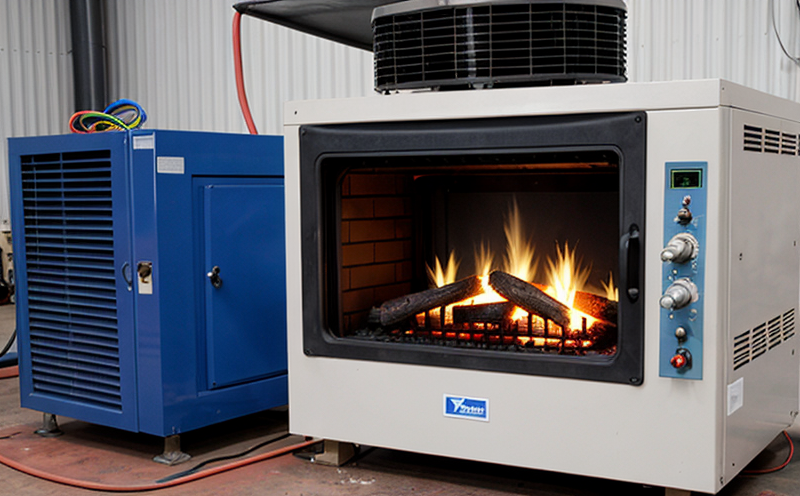IEC 60695 10 2 Heat Testing of Luminaires for Fire Hazard Assessment
The IEC 60695-10-2 standard is an internationally recognized protocol used to assess the fire hazard potential of luminaires. This test evaluates how a luminaire behaves under extreme heat conditions, simulating real-world scenarios where the lamp or fitting might be exposed to high temperatures. This testing ensures that products are safe from causing fires and can contribute to overall fire safety standards.
The test procedure involves subjecting a luminaire to a specified temperature for a defined duration, typically 18 minutes at 650°C (1202°F). The luminaire is placed in an oven or furnace, where it undergoes heating. Once the predetermined time elapses, the specimen is removed and inspected for any signs of ignition or flame propagation. The test aims to provide a baseline understanding of the luminaire's fire hazard potential.
Understanding this standard is crucial because it helps ensure that luminaires do not contribute to the spread of fire in environments such as homes, offices, or public spaces. By adhering to IEC 60695-10-2 guidelines, manufacturers can demonstrate compliance with international safety standards and gain consumer trust.
The test is particularly important for luminaire components that include lamps or materials prone to heat generation. These components are more susceptible to ignition under high temperatures. The standard ensures that such luminaires meet stringent fire safety requirements before they reach the market. Compliance with this standard can prevent potential hazards and contribute significantly to public safety.
Manufacturers who wish to ensure their products comply with IEC 60695-10-2 should familiarize themselves with the test procedure, including specimen preparation, heating conditions, and post-test inspections. This knowledge is essential for R&D engineers in developing fire-resistant luminaires that meet international safety standards.
The standard's application extends beyond individual product testing; it also supports broader quality assurance initiatives within organizations. By incorporating IEC 60695-10-2 into their compliance programs, companies can ensure that all products they produce or source are safe from fire hazards.
Why It Matters
The importance of fire safety cannot be overstated. Every year, fires cause numerous casualties and significant property damage worldwide. Luminaire design plays a critical role in preventing such incidents by minimizing the risk of ignition and flame spread.
- Prevent Ignition: Luminaires that meet IEC 60695-10-2 standards are less likely to ignite when exposed to high temperatures. This reduces the likelihood of accidental fires starting in homes, offices, or public spaces.
- Avoid Flame Spread: The test ensures that even if a luminaire does catch fire under extreme conditions, it will not propagate flames easily. This feature is essential for maintaining safety in densely populated areas where rapid fire spread can be catastrophic.
- Promote Consumer Trust: Compliance with international standards like IEC 60695-10-2 enhances consumer confidence in the product's quality and safety. It also helps companies comply with regulatory requirements, avoiding potential fines or recalls.
In conclusion, adhering to IEC 60695-10-2 is not just a technical requirement but a commitment to public safety. By incorporating this standard into their product development process, manufacturers can contribute significantly to fire prevention and overall safety in society.
Scope and Methodology
| Test Parameter | Description |
|---|---|
| Luminaire Type | The luminaire to be tested must meet the specified criteria, including lamp type or equivalent heat source. |
| Heating Conditions | The luminaire is heated in an oven or furnace at 650°C (1202°F) for a duration of 18 minutes. The temperature and time are critical to the test's success. |
| Post-Test Inspection | The luminaire is inspected immediately after removal from the furnace to check for signs of ignition or flame propagation. |
The IEC 60695-10-2 standard specifies a series of parameters that must be adhered to during testing. These include the type of luminaire, heating conditions, and post-test inspections. The test aims to simulate real-world scenarios where luminaires may be exposed to high temperatures, thus ensuring they do not contribute to fire hazards.
The specimen preparation process is crucial for accurate testing results. The luminaire must be prepared according to the standard's specifications, including the lamp type or equivalent heat source. Proper preparation ensures that all test parameters are consistent across different samples, leading to reliable and repeatable results.
After the heating period ends, the luminaire is removed from the oven and inspected for any signs of ignition or flame propagation. This inspection helps determine whether the luminaire complies with the standard's requirements. Compliance ensures that the product meets international safety standards and can be used in various environments without posing a fire hazard.
Quality and Reliability Assurance
- Consistent Testing Conditions: Adhering to IEC 60695-10-2 ensures that all luminaires undergo the same testing conditions. This consistency is vital for producing reliable results.
- Data Accuracy: Precise temperature and time controls are essential for accurate data collection during the test. Inaccurate measurements can lead to incorrect conclusions about a luminaire's fire hazard potential.
- Standard Compliance: Regularly reviewing and updating quality control measures ensures that all tests comply with international standards, maintaining product safety and reliability.
The IEC 60695-10-2 standard is designed to ensure consistent testing conditions across different luminaires. This consistency helps in producing reliable data and accurate conclusions about a luminaire's fire hazard potential. Regular reviews of quality control measures, including temperature and time controls, are crucial for maintaining high standards.
Compliance with international standards like IEC 60695-10-2 is essential for ensuring product safety and reliability. By adhering to these standards, manufacturers can produce luminaires that meet fire hazard assessment requirements, contributing to overall public safety.





